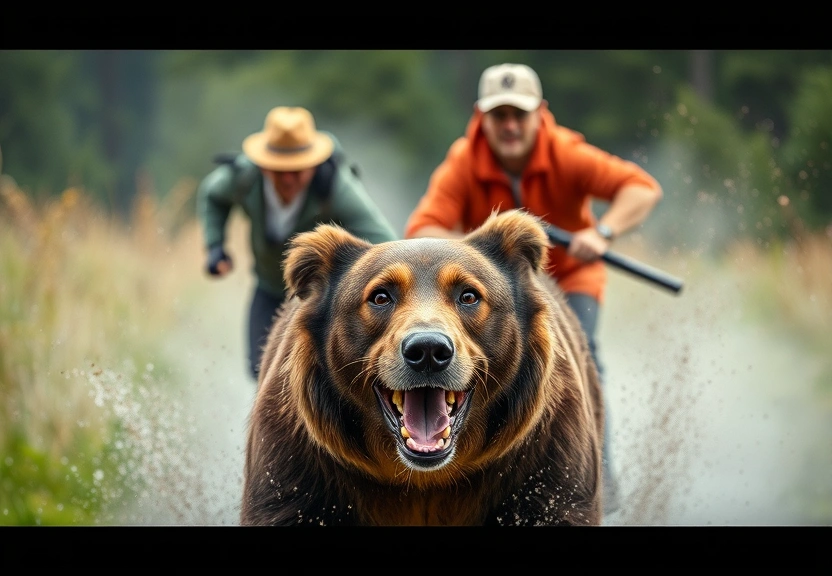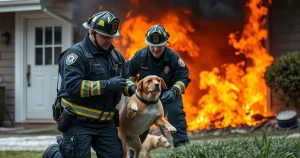Contents
ToggleTerrifying Bear Chase: Dog in Distress as Brave Owners Rush to Rescue
Late one evening in a serene suburb of Maple Grove, Minnesota, an ordinary night transformed into a gripping wildlife encounter that shocked residents and viewers alike. Security footage captured a startling scene: three black bears, appearing initially playful in a family’s driveway, turned the atmosphere from one of curiosity to sheer terror in a matter of moments. The family’s dog, caught unawares, became the center of a heart-stopping chase, prompting the owners to leap into action to protect their beloved pet.

This article delves into the details of this harrowing bear chase, the swift actions of the dog’s owners, and the broader implications of wildlife encounters in suburban areas. As urban development continues to encroach on wildlife habitats, understanding these encounters becomes increasingly vital for both residents and animal lovers alike.
The Initial Encounter: Bears in the Driveway
On that fateful evening, the tranquil setting of Maple Grove was interrupted when a trio of black bears wandered into a resident’s driveway. The moment was innocuous at first, as the bears rolled around playfully and explored the items left outside. Homeowners often find joy in observing wildlife, but this encounter quickly escalated into a dangerous situation when the family’s dog spotted the bears.
Behavior of Bears in Suburban Areas
Black bears, while typically shy and non-aggressive, can exhibit unpredictable behavior when startled or threatened. In suburban neighborhoods, their presence is often linked to searching for food, which can lead to encounters with pets and humans alike. Understanding their behavior is crucial in preparing for potential wildlife interactions.
- Bears are opportunistic feeders and are attracted to accessible food sources.
- Suburban areas often provide these sources, increasing the likelihood of bear encounters.
- When threatened, bears may react defensively, especially if they feel their territory is being invaded.
🎥 Assista esta análise especializada sobre Terrifying Bear Chase: Dog in Distress as Brave Owners Rush to Rescue
The Distress of the Family Dog
As the bears frolicked in the driveway, the family’s dog, a medium-sized breed with a protective instinct, became alarmed at the sight of the intruders. The dog’s barking was a warning that quickly escalated into a frantic attempt to escape the looming threat. Security footage captured the intensity of the chase, revealing the raw instinct of the dog to flee and survive.
Understanding Dog Behavior Around Wildlife
Dogs often react to wildlife encounters based on their instincts, training, and temperament. In this case, the dog’s response was to bark and run, a natural reaction to what it perceived as a threat. Here are some key points about dog behavior in these scenarios:
- Dogs may bark to assert dominance or warn off intruders.
- Flight responses are common when dogs feel threatened or cornered.
- A dog’s breed can influence its reaction, with some breeds being more protective than others.
Brave Actions of the Owners
As the bear chase unfolded, the dog’s owners did not hesitate. Their instinct to protect their pet kicked in, and they rushed into the driveway, calling for their dog and attempting to divert the bears’ attention. This brave intervention illustrates the bond between pets and their owners, showcasing human courage in the face of danger.
How to Respond in Wildlife Encounters
The actions taken by the owners highlight important strategies for managing wildlife encounters:
- Remain Calm: Panic can escalate the situation; staying calm helps you think clearly.
- Assess the Situation: Determine if it’s safe to approach or if you should maintain distance.
- Use Loud Noises: Shouting or using noise-making devices can help scare off wildlife.
- Protect Your Pet: If safe, retrieve your pet to ensure it is not in harm’s way.
- Contact Local Authorities: If the wildlife poses a threat, it may be necessary to call animal control.
Aftermath and Community Reactions
Once the bears retreated, the community buzzed with conversations about the encounter. Many residents expressed their relief that the dog was unharmed while also emphasizing the need for awareness regarding wildlife in suburban areas. This event served as a reminder that while nature can be beautiful, it can also pose unexpected challenges.
Community Awareness and Safety Measures
In the days following the incident, local officials and wildlife experts urged residents to take precautions when living near bear habitats:
- Secure trash bins and compost to reduce attractants.
- Keep pet food indoors and supervise pets when outside.
- Educate children about wildlife safety and respect for animals.
- Install bear-proof fencing if necessary in high-risk areas.
Frequently Asked Questions
1. What should I do if I see a bear in my neighborhood?
If you see a bear, stay calm and observe from a distance. Do not approach it. Make noise to alert the bear of your presence and encourage it to leave. If it remains, contact local animal control.
2. How can I protect my pets from wildlife encounters?
Keep pets secured indoors or on leashes when outside. Avoid leaving food outside and supervise them during outdoor activities.
3. Are black bears dangerous to humans?
Black bears are generally not aggressive toward humans, but they can become dangerous if they feel threatened or are protecting their cubs. Always maintain a safe distance.
4. What attracts bears to residential areas?
Bears are attracted to easily accessible food sources, such as garbage, pet food, birdseed, and even garden fruits and vegetables.
5. How can I help prevent bear encounters in my community?
Educate your neighbors about bear safety, secure food sources, and report any bear sightings to local wildlife authorities to ensure the community remains informed and safe.
Conclusion
The bear chase in Maple Grove was a stark reminder of the unpredictable interactions between wildlife and suburban life. While the incident concluded without harm to the dog, it highlighted the importance of preparedness and awareness in dealing with wildlife encounters. As urban areas expand, residents must remain vigilant and proactive in safeguarding themselves, their pets, and the wildlife that shares their environment. By fostering a respectful coexistence, communities can enjoy the beauty of nature while minimizing risks associated with wildlife encounters.
📰 Original Source
Este artigo foi baseado em informações de: https://iheartdogs.com/dog-chases-bear-owner-pursues/?utm_source=rss&utm_medium=rss&utm_campaign=dog-chases-bear-owner-pursues





